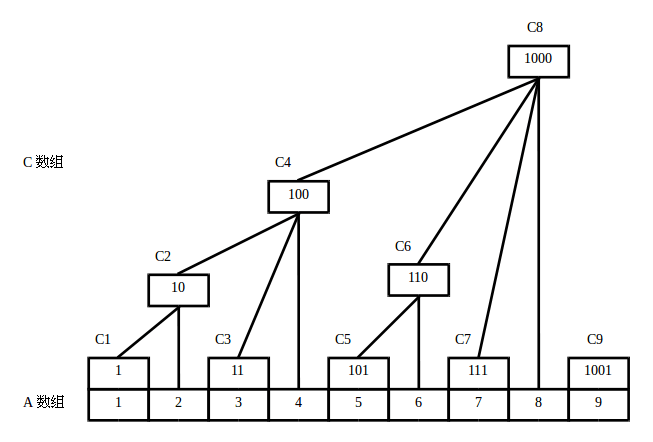树状数组/二叉索引树(Binary Indexed Tree):

A 数组就是原数组,C 数组则是树状数组。
通过观察可以发现:
1
2
3
4
5
6
7
8
9
10
| [1, 1] C1 = A1
[1, 2] C2 = A1 + A2
[3, 3] C3 = A3
[1, 4] C4 = A1 + A2 + A3 + A4
[5, 5] C5 = A5
[5, 6] C6 = A5 + A6
[7, 7] C7 = A7
[1, 8] C8 = A1 + A2 + A3 + A4 + A5 + A6 + A7 + A8
C[i] 管理的区间:[i - bitLow(i) + 1, i]
|
它的查询和修改的时间复杂度都是 O(logN),空间复杂度则为 O(N),这是因为树状数组通过将线性结构转化成树状结构,从而进行跳跃式扫描。
通常使用在高效的计算数列的前缀和,区间和。
模版
1
2
3
4
5
6
7
8
9
10
11
12
13
14
15
16
17
18
19
20
21
22
23
24
25
26
27
28
29
30
31
32
33
34
35
36
37
38
39
40
41
42
43
44
45
46
47
48
49
50
51
52
53
54
55
56
57
58
59
60
61
62
63
64
65
66
67
68
69
70
71
72
73
74
75
76
77
78
79
| class BinaryIndexedTree {
int length;
int[] tree;
BinaryIndexedTree(int length) {
this.length = length;
tree = new int[length + 1];
}
void put(int index, int value) {
while (index <= length) {
tree[index] += value;
index += lowBit(index);
}
}
int get(int index) {
int sum = tree[index];
int z = index - lowBit(index);
index--;
while (index != z) {
sum -= tree[index];
index -= lowBit(index);
}
return sum;
}
static int lowBit(int k) {
return k & -k;
}
int sum(int index) {
int sum = 0;
while (index > 0) {
sum += tree[index];
index -= lowBit(index);
}
return sum;
}
int sum(int start, int end) {
return sum(end) - sum(start - 1);
}
}
|

